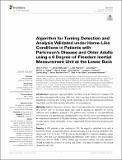Algorithm for Turning Detection and Analysis Validated under Home-Like Conditions in Patients with Parkinson?s Disease and Older Adults using a 6 Degree-of-Freedom Inertial Measurement Unit at the Lower Back
Author(s)
Pham, Minh H.; Elshehabi, Morad; Haertner, Linda; Heger, Tanja; Hobert, Markus A.; Faber, Gert S.; Salkovic, Dina; Ferreira, Joaquim J.; Berg, Daniela; Maetzler, Walter; van Dieen, Jaap H.; Sanchez Ferro, Alvaro; ... Show more Show less
DownloadAlgorithm for turning.pdf (2.599Mb)
PUBLISHER_CC
Publisher with Creative Commons License
Creative Commons Attribution
Terms of use
Metadata
Show full item recordAbstract
Introduction: Aging and age-associated disorders such as Parkinson’s disease (PD) are often associated with turning difficulties, which can lead to falls and fractures. Valid assessment of turning and turning deficits specifically in non-standardized environments may foster specific treatment and prevention of consequences.
Methods: Relative orientation, obtained from 3D-accelerometer and 3D-gyroscope data of a sensor worn at the lower back, was used to develop an algorithm for turning detection and qualitative analysis in PD patients and controls in non-standardized environments. The algorithm was validated with a total of 2,304 turns ≥90° extracted from an independent dataset of 20 PD patients during medication ON- and OFF-conditions and 13 older adults. Video observation by two independent clinical observers served as gold standard.
Results: In PD patients under medication OFF, the algorithm detected turns with a sensitivity of 0.92, a specificity of 0.89, and an accuracy of 0.92. During medication ON, values were 0.92, 0.78, and 0.83. In older adults, the algorithm reached validation values of 0.94, 0.89, and 0.92. Turning magnitude (difference, 0.06°; SEM, 0.14°) and duration (difference, 0.004 s; SEM, 0.005 s) yielded high correlation values with gold standard. Overall accuracy for direction of turning was 0.995. Intra class correlation of the clinical observers was 0.92.
Conclusion: This wearable sensor- and relative orientation-based algorithm yields very high agreement with clinical observation for the detection and evaluation of ≥90° turns under non-standardized conditions in PD patients and older adults. It can be suggested for the assessment of turning in daily life.
Date issued
2017-04Department
Massachusetts Institute of Technology. Research Laboratory of ElectronicsJournal
Frontiers in Neurology
Publisher
Frontiers Research Foundation
Citation
Pham, Minh H. et al. “Algorithm for Turning Detection and Analysis Validated under Home-Like Conditions in Patients with Parkinson’s Disease and Older Adults Using a 6 Degree-of-Freedom Inertial Measurement Unit at the Lower Back.” Frontiers in Neurology 8 (2017): n. pag.
Version: Final published version
ISSN
1664-2295